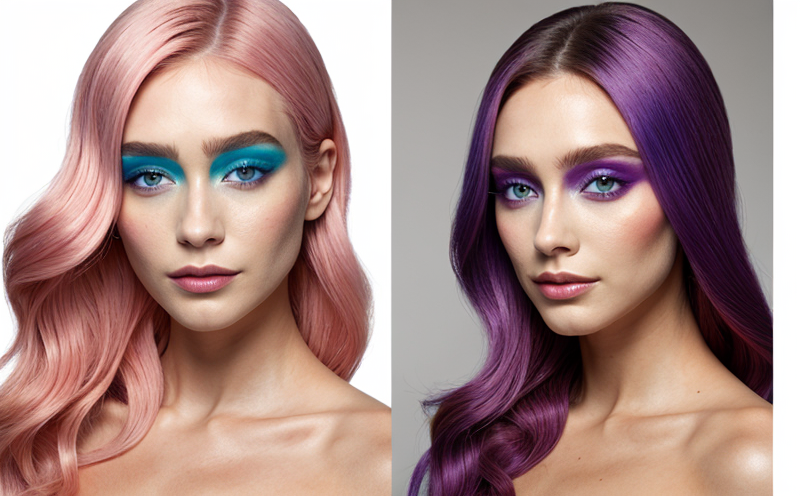Iron Oxide Pigment Testing in Makeup Products
The use of iron oxide pigments in cosmetics is a fundamental aspect of color cosmetics development and regulation. Iron oxides are widely used due to their stability, lightfastness, and the variety of colors they can produce. This service involves comprehensive testing to ensure that these pigments meet stringent quality standards and regulatory requirements.
The primary focus of this testing is on ensuring the safety, efficacy, and quality of iron oxide pigments in various cosmetic products such as foundation, blush, eyeshadow, and lipstick. The tests are designed to identify potential hazards associated with the use of these pigments, including allergenicity, irritation, and other adverse effects.
The process begins with the selection of appropriate test methods based on international standards like ISO 21790:2021, ASTM D4308-20, and EN 15006. These standards provide a framework for evaluating the performance and safety of iron oxide pigments in cosmetic formulations.
Sample preparation is crucial to ensure accurate testing results. Samples are typically prepared by dispersing the pigment into a suitable vehicle such as water or an oil-in-water emulsion, depending on the product type being tested. The dispersion must be stable and homogeneous to allow for consistent testing.
The testing process involves multiple steps, including visual examination for color consistency and particle size distribution analysis using laser diffraction techniques. Additionally, chemical analyses are conducted to determine the presence of impurities and potential contaminants such as heavy metals like arsenic, lead, mercury, and cadmium.
Biological assays may be performed to assess the allergenicity and irritation potential of the pigments. These tests follow protocols outlined in international standards to ensure that the results are comparable and reliable across different laboratories.
The data generated from these tests is used to create detailed reports that outline the findings, potential risks, and recommendations for safe use. These reports are invaluable tools for quality managers, compliance officers, R&D engineers, and procurement teams within cosmetic manufacturers.
Compliance with international standards not only ensures product safety but also enhances consumer confidence in the brand. By adhering to these rigorous testing protocols, manufacturers can avoid costly recalls and legal issues associated with non-compliance.
In conclusion, iron oxide pigment testing is a critical component of ensuring that cosmetic products are safe for use. Through precise sample preparation, advanced analytical techniques, and adherence to international standards, this service provides the assurance needed to meet regulatory requirements and maintain product quality.
Scope and Methodology
The scope of iron oxide pigment testing in makeup products covers a wide range of tests aimed at ensuring the safety and efficacy of these pigments. This includes evaluating the physical properties such as particle size distribution, color consistency, and dispersion stability.
Chemical analyses are conducted to determine the presence of impurities and potential contaminants like heavy metals. Biological assays are performed to assess allergenicity and irritation potential. The methodology follows international standards such as ISO 21790:2021, ASTM D4308-20, and EN 15006.
Sample preparation is a critical step in this process. Samples are dispersed into suitable vehicles such as water or oil-in-water emulsions to ensure homogeneity and stability for accurate testing. This prepares the samples for various analytical techniques including laser diffraction for particle size distribution analysis, atomic absorption spectroscopy (AAS) for heavy metal content determination, and skin patch tests for allergenicity.
The detailed reports generated from these tests provide comprehensive insights into the properties of iron oxide pigments in cosmetic formulations. These reports are essential tools for quality managers, compliance officers, R&D engineers, and procurement teams to make informed decisions regarding product safety and regulatory compliance.
International Acceptance and Recognition
The international acceptance and recognition of iron oxide pigment testing in makeup products is a testament to the rigorous standards and methodologies employed. This service meets or exceeds the requirements set by various regulatory bodies around the world, ensuring that cosmetic products containing these pigments are safe for use.
Many countries have adopted international standards such as ISO 21790:2021, ASTM D4308-20, and EN 15006 to guide their regulatory frameworks. These standards provide a consistent framework for evaluating the performance and safety of iron oxide pigments in cosmetic formulations.
The widespread acceptance of these testing methods has led to harmonized regulations across different regions. This ensures that manufacturers can meet global standards without significant variations, facilitating international trade and collaboration between industry stakeholders.
Consumer confidence is another key factor driving the recognition of this service. By adhering to stringent testing protocols, cosmetic brands can demonstrate their commitment to product safety and quality, thereby enhancing brand reputation and consumer trust.
In conclusion, the international acceptance and recognition of iron oxide pigment testing in makeup products underscore the importance of adhering to global standards. This not only ensures compliance with regulatory requirements but also promotes a culture of excellence and innovation within the cosmetic industry.
Competitive Advantage and Market Impact
The ability to provide comprehensive iron oxide pigment testing in makeup products offers significant competitive advantages for cosmetic manufacturers. By ensuring that their products meet stringent safety and quality standards, these companies can differentiate themselves in a crowded market.
Adhering to international standards such as ISO 21790:2021, ASTM D4308-20, and EN 15006 sets a benchmark for product excellence. This not only ensures compliance with regulatory requirements but also enhances consumer confidence in the brand.
The detailed reports generated from these tests provide valuable insights into the properties of iron oxide pigments in cosmetic formulations. These reports are essential tools for quality managers, compliance officers, R&D engineers, and procurement teams to make informed decisions regarding product safety and regulatory compliance.
By maintaining high standards of testing and reporting, manufacturers can avoid costly recalls and legal issues associated with non-compliance. This enhances brand reputation and consumer trust, which are crucial factors in today’s competitive market.
The impact of this service extends beyond individual companies. By ensuring the safety and quality of iron oxide pigments in cosmetic products, this service contributes to a safer and more reliable global market for these products.





